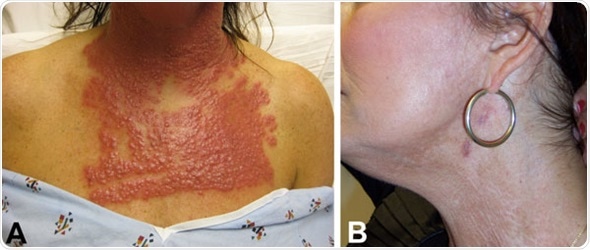Just as with plants, germs are segregated into a variety of categories, known as families. The Mycobacteriaceae family represents one family of bacteria. Several species exist in the Mycobacteriaceae family but only certain species, known as pathogenic Mycobacteriaceae, can lead to the onset of human disease. Other species, termed saprophytic Mycobacteriaceae, do not lead to the onset of human disease or illness.
Nontuberculous mycobacteria, also known as NTM, are representative of Mycobacteriaceae species that can lead to human illness, but which are not the causative agents of tuberculosis. Such types of NTM are present naturally in the soil and in the air.

A) Neck and chest of a 53-year-old woman (case-patient 1) 14 days after fractionated CO2 laser resurfacing. B) Neck of the patient after 5 months of multidrug therapy and pulsed dye laser treatment. Image Credit: CDC
Most Common NTM
Among the more common nontuberculosis mycobacteria that must be therapeutically addressed are M. avium, M. intracellulare, M. kansasii, M. abscessus, M. chelonae, M. fortuitum, M. terrae, M. xenopi, and M. simiae. One well known mycobacterium – M. leprae – is the cause of leprosy.
NTM Onset
In the United States, on an annual basis, approximately 2 out of 100,000 people will become infected by NTM. A person can become infected with NTM of the lung when they breathe in mycobacteria from the air around them. But not everyone, in actuality, who takes in air will fall sick. Yet those that do are very susceptible to a slowly advancing illness that eventually can cause great or irreparable harm and damage.
Scientists have found it difficult to determine any actual method of disease transmission in humans. Person-to-person transmission does not occur all of the time, as with tuberculosis. People do not become infected directly from animals either, although indirect infection, such as from sharing drinking water, is possible. Based on the manner in which NTM exist in the environment, infected people most often will have consumed or inhaled the bacteria. Whilst the exact route of NTM infection has not yet been established, the environmental distribution of NTM suggests that the ingestion or inhalation of the organism can result in infection.
NTM can cause problems in patients once the bacteria reach the lungs and pulmonary system. In most people, the lungs rid themselves of the bacteria. Yet in others, NTM can infect the pulmonary system, including the lungs, resulting in illness. Essentially, this infection leads to the development of an inflamed respiratory system.
Symptoms and Diagnosis
Older adults are more commonly afflicted than those younger, although the condition can affect anyone at any time. Improper treatment of patients can result in progressive lung infection, symptoms of which could include exhaustion, weight loss, and chronic coughing, and which would require continuous therapy. A long course of therapy with several drug combinations is often needed to cure the illness. Although NTM infections of the lungs seldom are the direct cause of death, they can significantly negatively affect one’s quality of life.
Diagnosis may involve:
- Taking a medical history of the patient.
- Imaging the chest-lung area with a CAT scan.
- Culturing the sputum of the lungs.
- Scoping the airway.
Epidemiology
Many believe that over the last 30 years there has been a steady growth in the occurrence of NTM and that it has become more widespread. Part of this disease evolution could be the result of greater awareness, an increase in prevalence, as well as optimized culturing methodologies.
But trying to precisely characterize the incidence and prevalence of NTM infection is not an easy task. Isolating the bacteria does not necessarily mean that a person is infected. Moreover, it is not necessary to report the existence of NTM infections. This can impede a full appreciation of the disease’s patterns, causes, and impact on a population’s health. Additionally, worldwide NTM prevalence may not be understood since for the most part, epidemiologic information is sourced in the United States, Europe, and Japan.
Last Updated: Feb 27, 2019